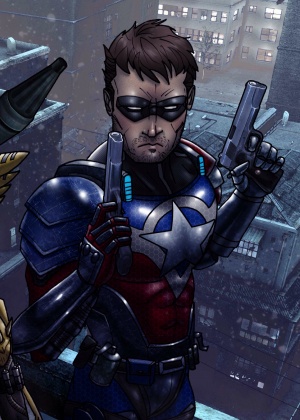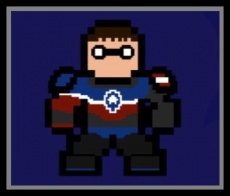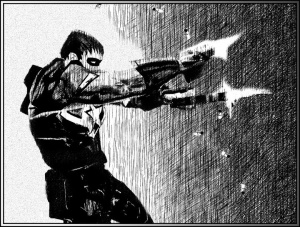Citizen 13
|
The author of this article has marked this as a creative work, and would prefer that other users not edit it. Please respect this, and unless repairing a typo, spelling, or other minor technical error, think of this page as read-only. |

| "Luck has nothing to do with it."
| ||||||||||||||||||||||||||
| Player: @maxymus | ||||||||||||||||||||||||||

| ||||||||||||||||||||||||||
| Character Build | ||||||||||||||||||||||||||
| Class Focus: | DPS | |||||||||||||||||||||||||
| Power Level: | 40 | |||||||||||||||||||||||||
| Research & Development: | Arms (Ordnance) | |||||||||||||||||||||||||
| Biographical Data | ||||||||||||||||||||||||||
| Real Name: | James Rodgers | |||||||||||||||||||||||||
| Known Aliases: | Citizen Thirteen, Thirteen, Captain Kickass(by Little Devil), Lone Star(for a short time) | |||||||||||||||||||||||||
| Gender: | Male | |||||||||||||||||||||||||
| Species: | Human / Super Human | |||||||||||||||||||||||||
| Ethnicity: | Caucasian | |||||||||||||||||||||||||
| Place of Birth: | Beaumont, Texas | |||||||||||||||||||||||||
| Base of Operations: | Millenium City | |||||||||||||||||||||||||
| Relatives: | None | |||||||||||||||||||||||||
| Characteristics | ||||||||||||||||||||||||||
| Age: | 40 years estimated of unfrozen activity (92 in actual time) | |||||||||||||||||||||||||
| Height: | 6' 1" | |||||||||||||||||||||||||
| Weight: | 270 lbs | |||||||||||||||||||||||||
| Eyes: | Blue | |||||||||||||||||||||||||
| Hair: | Brown | |||||||||||||||||||||||||
| Complexion: | Rough | |||||||||||||||||||||||||
| Physical Build: | Muscular, Athletic | |||||||||||||||||||||||||
| Physical Features: | Bionic left arm, patriotic body armor | |||||||||||||||||||||||||
| Status | ||||||||||||||||||||||||||
| Alignment: |
Chaotic Good | |||||||||||||||||||||||||
| Reputation: |
Memorable | |||||||||||||||||||||||||
| Identity: | Not secret | |||||||||||||||||||||||||
| Years Active: | Off and on between 1945 and 1977, and from 1999 to present day | |||||||||||||||||||||||||
| Citizenship: | United States Citizen | |||||||||||||||||||||||||
| Occupation: | Patriotic Icon, Super-Soldier | |||||||||||||||||||||||||
| Education: | High School education, Military training, specialized education in various languages and cultures. | |||||||||||||||||||||||||
| Marital Status: | Dating Francesca Peretti | |||||||||||||||||||||||||
| Known Powers and Abilities | ||||||||||||||||||||||||||
| Superhuman reflexes and endurance. Olympic level strength. Patriotic fervor. Expert marksman and gunslinger. | ||||||||||||||||||||||||||
| Equipment and Paraphernalia | ||||||||||||||||||||||||||
| Custom patriotic themed body armor(standard suit is made mostly of Regor plastics, Kevlar, and some Kendrium), repulsor jump boots, personal teleporter. Common weapons include dual Colt 1911 XSE .45's, Bushmaster ACR, assorted grenades. A Bionic arm built from Kendrium, equipped with a variety of useful utilities, such as a taser, lock pick, EMP, adrenaline/bio foam injector, and deployable energy shield that is able of stopping most kinetic projectiles. | ||||||||||||||||||||||||||
| Attributes | ||||||||||||||||||||||||||
| Strength |
|
Endurance |
|
|||||||||||||||||||||||
|---|---|---|---|---|---|---|---|---|---|---|---|---|---|---|---|---|---|---|---|---|---|---|---|---|---|---|
| Agility |
|
Speed |
|
|||||||||||||||||||||||
| Fighting |
|
Projectiles |
|
|||||||||||||||||||||||
| Durability |
|
Resistance |
|
|||||||||||||||||||||||
| Intelligence |
|
Psyche |
|
|||||||||||||||||||||||
| Intuition |
|
Charisma |
|
|||||||||||||||||||||||
| ReldinBox Template | ||||||||||||||||||||||||||
If there was only one word to describe Citizen Thirteen, then it would be the most bad ass, American word ever, and they'd have to put it in the New Oxford American Dictionary with a picture of Citizen Thirteen beside it. Citizen Thirteen is a patriot and a warrior, a defender of freedom and protector of the American people. He is an expert in small arms and hand to hand combat. He is most notable for his patriotic attire, his dual Colt 1911's, and bionic arm. A product of the post-World War I era, the Great Depression, and World War II. In 1940, James Rodgers enlisted to serve the US Army as an Airborne Ranger in the European campaign. Towards the end of the war, he lost his left arm in combat and was transported to Walter Reed Hospital in Washington, DC. This was where he was recruited for Project Citizen, a program designed to put disabled veterans, who still had a strong desire to serve, back into action as "super-soldiers".
From 1945 to 1977, James Rodgers was known as "Citizen Thirteen", as he was the thirteenth operative added onto Project Citizen's roster. The Citizen's were one of America's most elite Black Op groups of that era, specializing in recon, search and rescue, training friendly forces, espionage, sabotage, and capture-or-kill missions. Often their missions were conducted in the gray area of morality. This didn't always sit well with James, but they were Soldiers, and following orders was part of their duty.
By 1977 the roster for Project Citizen had diminished greatly, and the commander of the project was revealed to be a double agent, working for a special section of the KGB. Thirteen was forced into cryogenic storage and intentionally mislabeled and lost. He stayed this way for twenty three years.
Sometime in 1999, completely by chance, Kenshin DeLeon(a ronin warrior) recovered the cryogenic chamber and released it's inhabitant. Once again James had a choice; he could live out his life as a regular civilian, or continue to follow his heart and serve. With the age of super-heroes in full swing, Kenshin was able to convince James to use his old name and military training and become something more than just a soldier. Donning a domino mask and body armor colored to represent his patriot spirit, James Rodgers began to redefine what "Citizen Thirteen" stood for. A defender of the American dream. A citizen, standing up for what is right, for the betterment of the United States.
Citizen Thirteen loves his country, he loves his guns, and he loves to have a good time at the local VFW when the old timers get together to have a few beers.
Contents
ORIGINS
Before I begin on the history of James Rodgers, aka Citizen Thirteen, I want to share a statement he once gave during an interview. The statement was in response to the question "Why do you do it, why do you still continue to serve our country after so many years of doing so?" I believe this statement alone reveals more about who Citizen Thirteen is than anything else that will be included in my report.
"When I first joined the Army, I did so because I wanted to be like my Pa. Serving came with a sense of pride, pride in myself and in what my father had done before me. I felt like I understood my father more, and I felt like I was doing something truly good, something worth doing.
After the war ended in 1945, I still had that pride, but there was something else that motivated me to join Project Citizen. It felt like an obligation, or a calling, a duty, whatever. Like if I didn't do it I would be letting someone down. We had just won the war, we were the heroes of the world! We had a responsibility now, to be examples to others to stand up against any evil out there that tried to bully the little guy. I truly believed that. I still do, but it's obviously not so black and white these days.
So I agreed to join Project Citizen and become something more. For the times, our combat effectiveness was unmatched. It was a great feeling to not only be able to fight the threats of the world more effectively, but to feel like our efforts were saving the lives of other troops on the front lines. Course I didn't know that Project Citizen had such a dark side. How they willingly accepting such a high casualty rate just to get a handful of us through the initiation process... Can't say what was produced was worth risking a man's life. So when we, I mean, those of us that had become 'Citizens' found out about that, it really pushed us to go above and beyond what we'd accomplished in prior missions. Our motivations to fight had changed at that little revelation. We weren't just fighting for our country or to assist our Armed Forces, but we had to justify those lost to the damned initiation process. We felt... tarnished, I guess. And of course how we were utilized in Vietnam didn't help any.
And yet here I am, decades later, still 'fighting the good fight'. I suppose it's hard to see why I'm still willing to serve after so many bad decisions on our government's part. This country has really given itself a rough image since Vietnam. The American People are more cynical than ever, less trusting of the government than ever. And ya know what? They should be. There's nothing wrong with questioning your government and holding them accountable for their actions. In fact, that's how America is suppose to be. We just got lazy somewhere along the way, and let things get out of hand.
Getting back to the question at hand, what do people expect me to do? Retire? I've no right to retire. I'd be giving up on everything my brothers and sisters in arms have done, and demeaning the sacrifices they made for this country. Hell, I'm made for this, and I wouldn't want it any other way. But everyone ain't like me, the average service-member lacks special abilities, and let's not forget that they have families to go home to. They ALL sacrifice, so we damn well better ensure that our country continues to be worth the sacrifice. Despite having gotten a little sloppy lately, we are still the greatest nation in the world, we are still the Alpha, and I'll be doing what I do until the end of my days to help make sure we stay that way."
Early Life
James Rodgers was born on July 10th, 1922. His parents owned a farm out of Beaumont, Texas and he grew up as an only child. James had a deep respect for his father, who had served in WWI and was a decorated veteran. Growing up, his father taught him how to live off the land, how to fish, to hunt, and most importantly, to shoot. James' father was a hero in his eyes, and this would later factor in on James' decision to enlist in the U.S. Army.
In 1938, James' father passed away. After his father passed, James' mother sold the farm despite his protests to keep it, and they moved to live closer to relatives in Dallas. James never truly forgave his mother for this. In 1940, at the age of 18, James enlisted into the U.S. Army to become an Airborne Ranger. It is unknown if he ever spoke to his mother again.
After the United States entered WWII, James conducted his tour of duty in Europe. He saw a great deal of combat over the course of his tour, and received a battlefield promotion to Sergeant after displaying a level head and a solid ability to lead men into combat. Despite having participated in numerous heroic and brutal assaults against the Germans throughout the war, James had came out from most of these engagements with only a few minor injuries. But as the end of the war drew near, James' luck seemed to run short.
According to reports written by James' superior officers, plus testimonies given by fellow brothers-in-arms, James' final combat actions in WWII were credited as valorous beyond measure and the finest example of the determination needed to win the war. The engagement had been a minor one, so not many details of said engagement were recorded and preserved. From what reports are available, we gathered that James' company had encountered a German force that pushing back against advancing U.S. troops, causing James' company to halt in their movement and dig into defensive positions. I'd like to include in my report that despite how the engagement was won, it had been a sound decision to dig in defensively on part of the company commander due to the fact that the enemy force's numbers were unknown at the time. The Germans dropped artillery on them while simultaneously charging their defenses, but the U.S. soldiers held their ground. During one such rush of Nazi troops, a German grenade found it's way into the foxhole that James had been sharing with five other members of his platoon. James was first to react, grabbing the grenade to throw it back to the Germans. As he pitched it over the lip of his foxhole, the grenade detonated and took James' left arm with it. Despite the loss of his arm James continued to fight. The loss of his arm seemed to send him into a rage, instead of incapacitating him from further combat and going into shock. Likely experiencing "Doc Holiday" syndrome, he drew his Colt 1911 .45 ACP and sprung from his foxhole, rushing the Germans. James sprinted towards the closest Nazi he laid eyes on and waited to fire until he was within range of his sidearm. They say he only paused in his charge to reload. Holstering his 1911 to free his remaining hand, he would produce a fresh magazine and insert it into the mag well, then drew and continuing his assault. Others quickly mimicked his furious charge, and soon enough the entire company had begun a suicidal assault on the Germans. James had continued his assault for several minutes before passing out from blood loss and pulled from the front lines.
As it turned out, the German force was much smaller than anticipated. They had taken a big gamble at being overly aggressive to seem as if they were a larger force with many in reserve. Some called the company extremely lucky, as their victory in this engagement likes could have been a massive failure instead, but many from the unit cockily proclaimed that luck had nothing to do with it.
Medically evacuated out of Germany, James was sent to Walter Reed Army Medical Center for rehabilitation. This was where he first met Commander Grey and was recruited for "Project Citizen".
Over the course of his service in the United States Army, James had been awarded three Purple Hearts, one Bronze Star(with Valor), and the Distinguished Service Cross. He earned a Combat Device for his Parachutist Badge, and the Combat Infantry Badge as well. His recorded rank by the end of his time in service in 1945 was Sergeant/E-5.
Project Citizen
The United States government funded Project Citizen with the intention of creating an elite force of super-soldiers for the Armed Forces. But due to the high failure rate in the creation of said soldiers, research and recruitment for the project was shut down. Project Citizen, with the handful of soldiers that were successfully produced, became a covertly ran program that was independent from the Armed Forces.
Initial recruitment for Project Citizen targeted disabled combat veterans who could not return to active duty, yet displayed a fervent desire to return to do so. The official reasoning for the decision to target disabled vets was "to give service members a second chance". It should be noted that the recruits were never made fully aware of the risks involved in the program until after a recruit went through all three phases and was introduced to the other members of Project Citizen. Many of the recruits who died likely would not have signed their medical waivers if they had been aware of all the risks involved.
Initiation into Project Citizen had a three phase process. Phase One saw that potential recruits were screened for tissue compatibility, followed by extensive psychological testing. Recruits were then stress tested, physically and mentally, to weed out all but the most determined and strong willed. Food and sleep deprivation, physical torture, and mind games were all used on the candidates, despite their physical handicaps. Those who washed out were well compensated for their efforts, given state-of-the-art prosthetics of that era, and offered jobs elsewhere to continue to support the Armed Forces.
Phase Two was kept top secret for many, many decades. Much of what we now know has come to light only from statements given by James Rodgers, as the majority of files on Project Citizen were destroyed long ago. For many years, the cover story used was that the candidates were injected with an experimental super-soldier serum known as the "US Citizen Serum". Rumors were generated that the serum was the literal essence of American patriotism that existed in the country during WWII, harnessed into a liquid form that bestowed powers on those who drank it. Few took this seriously however, and those who did also likely believed in Scottish unicorns and giant miniature space bees.
In truth, Phase Two relied heavily on advanced(for its time) bioengineering. Four different organic appendages were created to enhance preexisting organs. The creation of the bioengineered organs and the surgical processes involved were known only to the research and surgical teams, the candidates who went through initiation, and a select few US Senators and Army Generals. Not even the staff that headed the program throughout the Cold War were allowed to know the truth. This was done mainly done for operational security reasons and to keep the scientists involved as safe as possible from being targeted by spies.
The organs were as followed,
The Lysandus, aka the "Heart": This bioengineered appendage is surgically fused to the heart. The Lysandus causes a multitude of positive changes to individuals who survived implantation. It secretes hormones that promote rapid muscle growth and bone density, increases blood flow and creates a higher haemoglobin content in the blood, regulates and improves the cardiovascular system, promotes a more effective immune system, and helps screen for poisons in the blood.
The Helbrechor, aka the "Mind": This appendage, which is about half the size of a marble, is implanted into the back of the skull, just above the cerebellum. This was the most dangerous implantation performed, but perhaps the most important tool of the Citizens. The "Mind" serves to give the recipient greater control over their motor skills and balance, on top of better control of emotions. It also increases the rate at which the recipient is capable of learning, making the acquisition of complex and thought demanding skills seem effortless, on top of allowing these new skills to be performed reflexively.
The Occuliris, aka the "Eye": Fused with the optic nerve, this tiny appendage simply perfects the vision of the recipient, as well as increases low light vision. The best modern example to use is to compare a dark setting in a video game, and then turn the brightness up so that objects hidden in the dark become easier to see. Hey, don't judge me for what I do when I'm not filling out metahuman reports for PRIMUS.
The Mauridius, aka the "Ear": This implantation is rather simple compared to the other three. The "Ear" provides protection to the ear drum from loud noises and explosions by instantly blocking the ear canal as soon as noise levels become too high. It also prevents dizziness and nausea caused by motion sickness.
Phase Two could take up to six months to complete, depending on the patient's recovery time. It also had a poor success rate. The surgical implantation of these bioengineered appendages occurred during the first two months, beginning with the "Heart" so that the healing process would be smoother for the other organs. More than what should have been deemed acceptable died in the first month, as often the appendages were rejected and infection would set in. In other cases, the recipients would develop cancerous tumors throughout their body within hours of receiving the implants. This became the main reason Project Citizen did not go into large scale production, although the program did serve as a stepping stone for many future super-soldier projects.
Phase Three began as soon as a recruit had properly bonded with their enhanced organs. The surviving recruits were then given state-of-the-art bionics to compensate for any appendages they may have lost during the war. Bionics then were not nearly as reliable as modern day bionics, but they were still very capable and had no real drawbacks compared to flesh and bone.
POWERS AND EQUIPMENT
Enhanced Attributes
Skills and Abilities
Firearms and Accessories
M1911A1 - James' service pistol from WWII. The most American handgun ever created.
D&L Custom 1911s - Custom 1911s, Citizen Thirteen's main on-the-job carry weapons.
Colt Officer Model 1911 - His EDC(every day carry) pistol when in civilian attire. All the legit bad asses have a black 1911 with ivory white grips.
Colt "100 Years of Service" 1911 - A decorative collectors item, the official "100 Years of Service" anniversary edition. Limited numbers of these were produced and sold at auctions in 2011, this one was gifted to James by a close friend. James uses this as a display piece only!
Colt Mustang XSP .380 - Nobody likes to use .380 caliber handguns for self defense if there are higher caliber options available, but if you need something small enough to hide in your pocket(or underpants teehee) then this is James' preferred piece.
Colt Anaconda .44 / Python .357 Magnum - Let's be honest, Dirty Harry would have been WAY cooler if he had used one of these. The Anaconda and Python both have amazing reputations, it's a wonder Colt stopped manufacturing these over ten years ago. James has been seen carrying these handguns on occasion, but revolvers in general aren't a practical EDC option for his line of work. Situational use only.
Mossberg 500 Pump - The Mossberg 500 is a simple, yet reliable shotgun that has served the US Military for years now. James has a variety of these shotguns with different setups for different situations. Accessories not included, but are preferred!
M21 Rifle - Nothing beats a good old-fashioned M21 with a wooden stock. Some times the old ways are the best ways. When working alongside military forces and asked to carry out the role of a designated marksman, this is James's preferred rifle.
Adaptive Combat Rifle - The go-to rifle of choice. Can be modified per situational needs. Longer and shorter barrel options, ambidextrous controls, and easy to swap internals for changing to different calibers. Comparable to the FN Scar, but made in America. Win!
Stoner M63 - James has been known to carry this when deployed alongside military forces. One of his favorite LMGs.
SAW M249 - A tried and true squad automatic weapon. When modded properly, this LMG can perform in almost any role that the military may need. Extremely easy-to-manage recoil and amazing accuracy, it's no wonder why this weapon has become the primary LMG used by the US military. James also like. Ares Shrike 5.56mm - James likes to carry this one when deploying with Marines. He does this because he likes to show off just how great a gun the Shrike is, and what exactly the Marines are missing out on for choosing an HK416 as the new weapon for their SAW program. Idiots! You replaced an LMG with an assault rifle when you specifically asked for a new LMG to fill the role of the M249! Bah!!!!
The M60(M60E4, to be precise) - The king of LMG. This modified and updated version of the American classic is James' absolute favorite machine gun, and second favorite firearm, ever. He keeps one in the trunk of his patrol vehicle at all times.
Costumes / Body Armor
AFFILIATES
GALLERY













